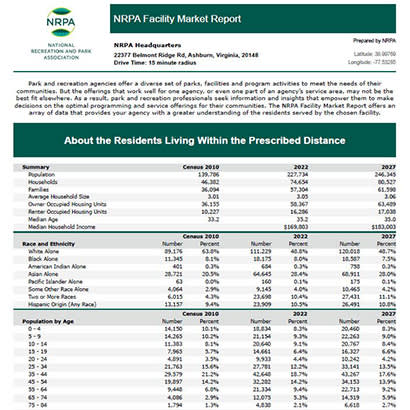
For an enhanced digital experience, read this story in the ezine.
One rarely moves to a new area without doing a little research on the neighborhood first. The same is true for park and recreation professionals. Whether you’re looking to construct a new park, explore new programming or evaluate your current resources to better serve the community, it is always good practice to get to know your neighbors.
NRPA Facility Market Reports (FMRs) offer key data and insights about the residents served by your agency’s facilities, with information from trusted sources, such as the U.S. Census Bureau, geographic information system company Esri and market research firms like MRI-Simmons. FMRs give park and recreation professionals a greater understanding of the residents served by a park, aquatics center, recreation center or any other established facility, using data that focus on residents’ behaviors, habits and interests. It also is a great first step in evaluating new and potential locations.
FMRs are not just for park and recreation professionals — they are a valuable asset to contractors, planners and other key stakeholders involved in all aspects of parks and recreation. Take the example of a park and recreation agency receiving a grant to establish a community pool. The agency knows two of its local parks could accommodate a new pool and both areas have a seemingly similar need. Staff will need to assess which location could serve the most people, how far people will travel to use the pool, and which location’s residents would most utilize the pool. An FMR is an easy and affordable way to gain insights to those initial questions. By requesting an FMR for each location and indicating the distance of analysis (e.g., 10-minute walk, 15-minute drive), you will be able to compare the total population, the number of households, the percent of the population enrolled in kindergarten through 12th grade, the percent of population that participated in swimming in the past 12 months and more. This information will help you and your agency to make more informed decisions.
Two unique indexes found in the FMR are the Spending Potential Index (SPI) and Market Potential Index (MPI). The SPI represents the amount spent in the area relative to a national average of 100. For example, an SPI of 110 means that the area spends 10 percent more than the national average on that good or service. An FMR examines the SPI and average amount spent on fees for participating in sports, for recreation lessons, and for childcare (among other things) within the area of analysis. Knowing the SPI for an area helps you understand where and how money is being spent, and how to assess fees and pricing for your agency’s activities and programs.
The MPI represents the relative likelihood of usage in comparison to the national average. This measure is indexed to 100, meaning an MPI greater than 100 indicates a higher-than-average likelihood (relative to the whole United States) for the specified factors. In the context of the FMR, the MPI is available on everything, such as whether individuals within the area spend seven or more hours exercising per week, spent more than $250 on sports equipment in the past 12 months, or even used prescription drugs for high blood pressure or cholesterol. These data points may indicate areas of opportunities for new or expanded programming at your agency.
The NRPA FMR is an NRPA Premier member benefit. Staff at these agencies have access to a set number of free FMRs each year. If you need FMRs beyond your agency’s annual allotment, additional reports are available for a modest fee. A park and recreation agency that is not a Premier member can still request an FMR for a small fee.
Whether you need a single report focused on a park or would like a custom report produced for each of your agency’s sites and facilities, place your request at nrpa.org/FMR. It is never too late to get to know your neighbors.
Melissa May is Senior Research Manager at NRPA.

